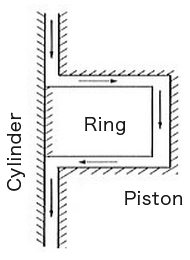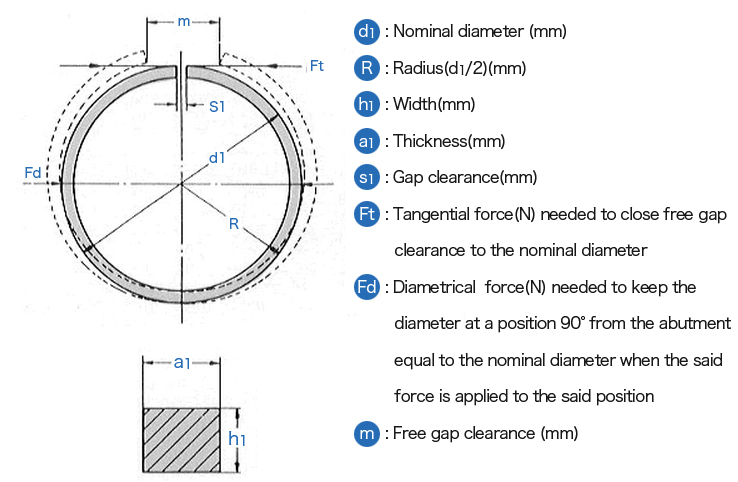Technologies that Assure Ring Function
C-3 Gas Sealability (3)Controlling Flutter & Ring Position
If the piston ring in the running engine does not stay seated against the piston groove, a possible leakage path for combustion gas is created. When a ring moves upward in the piston groove, a condition known as ring lift may be occurring. Rapid up-and-down movement of the ring in the groove is referred to as fluttering. Such ring movement is unwanted and contributes to pressure leakage from the combustion chamber. A variety of technologies are employed to control ring position and prevent fluttering during engine operation.

The figure to the left shows a simplified drawing of a power cylinder. You can see that the ring has lifted off the bottom flank of the piston groove, allowing combustion gas to pass (leak) behind it.
There are several ways to prevent this lift. We will now focus on one such method: adjusting the closed gap dimensions (S1) of the upper and lower compression rings (Top and 2nd rings).
In the figure below, the 'S1' dimension refers to the closed gap (gap clearance). This is the gap that remains between the ring ends when the ring is closed to its working diameter (cylinder bore diameter).

This closed gap is very small, mere fractions of a millimeter, but it is always there when the ring is closed to its working diameter. Under both high and low temperatures, there is a temperature difference between the piston ring and the other cylinder components (cylinder & piston, etc.). Additionally, the materials of each component are usually different resulting in different rates of thermal expansion for the cylinder, piston, and piston ring. Taking these factors into consideration, the closed gap must be designed in a way to prevent the gap ends of the closed ring from contacting each other.*1
Since S1 must be a positive number, the ring always has a slight gap opening (usually about 0.3mm) while the engine is operating. Even though this gap is very small, there is still slight gas pressure leakage that could lead to ring flutter. By balancing the S1 values of the Top and Second rings (gap balancing), the ring designer can achieve a balance of pressures, such that the pressure between Top and 2nd rings is never sufficient to lift the Top ring from its seat on the bottom flank of the piston groove during the phase of highest cylinder pressure (combustion/expansion stroke). This gap balancing or adjusting the closed ring gaps (s1) of the compression rings is an accepted method for minimizing top ring flutter and its negative effects on cylinder gas sealing.
- *1 The piston ring in the free state is shown by a virtual line (dotted line). When not mounted into the cylinder, the gap opens the equivalent of the dimension 'm.' This is referred to as the total free gap.






